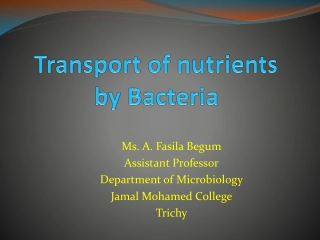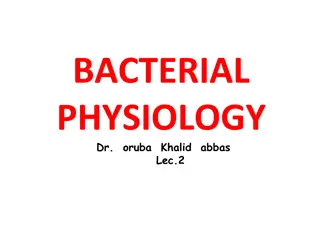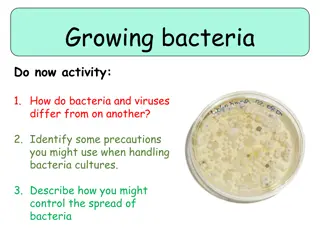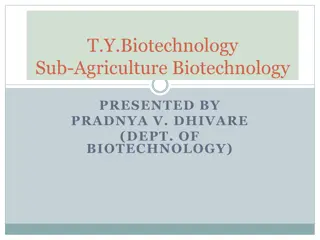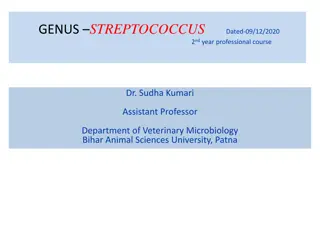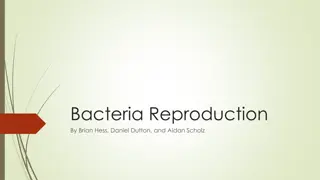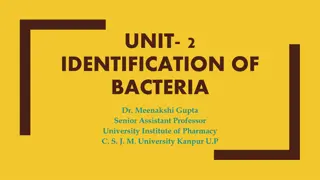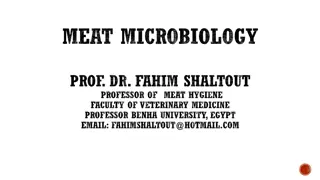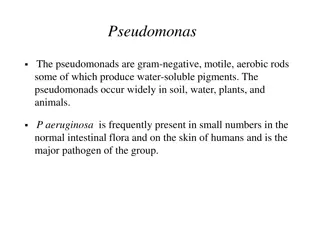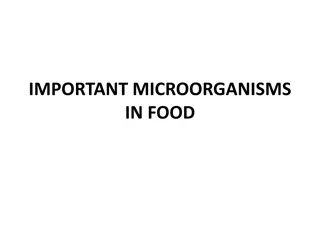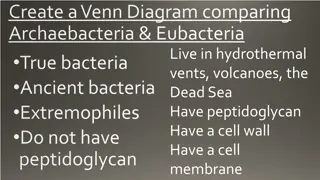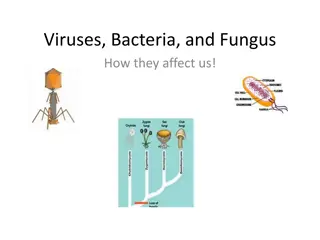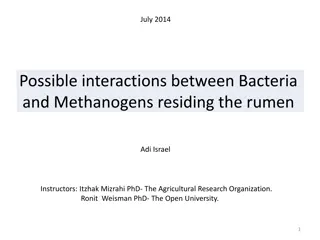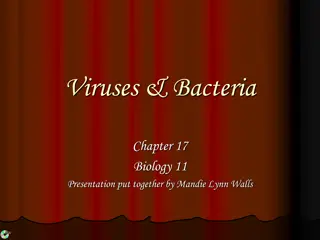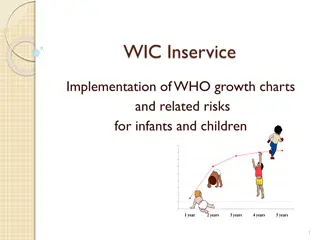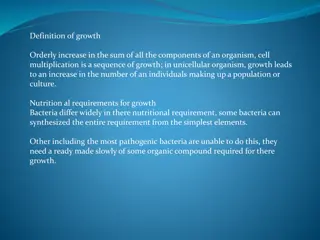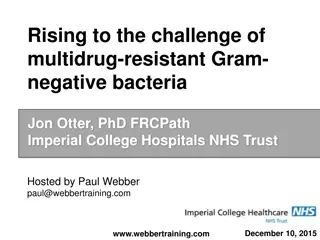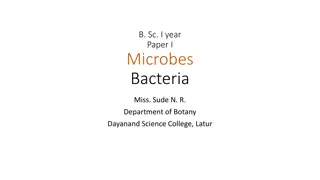Nutrient Uptake in Bacteria: Mechanisms and Factors
The process of nutrient uptake in bacteria, including the role of macronutrients, micronutrients, and environmental factors. Learn about the different mechanisms of nutrient transport and the importance of selective permeability in plasma membranes.
0 views • 25 slides
Wales in a global context: enhancing learners’ skills
World of bacteria through the lens of mathematics and science. This educational material delves into the characteristics, importance, and impact of bacteria on the environment and human health. From their small single-celled structures to their role in ecosystems, learn about the significance of bac
0 views • 10 slides
Understanding Food Safety in Hospitality and Catering
Learners will explore food-related causes of ill health in hospitality and catering, including microbes and bacteria that can lead to food poisoning. Factors such as warmth, time, food supply, and moisture create ideal conditions for harmful bacteria to thrive and cause illness. This topic covers fo
5 views • 75 slides
Understanding Bacterial Pathogenesis: Key Concepts and Factors
Bacterial pathogenesis involves the ability of certain bacteria to cause disease by attributes such as transmissibility, adherence, motility, invasion, and toxigenicity. Pathogens can exploit host defenses, while virulence determines the severity of infection. Learn about opportunistic pathogens, no
7 views • 36 slides
Anaerobic Bacterial Infections: Overview and Clinical Implications
Anaerobic bacterial infections are caused by bacteria that do not require oxygen for growth, posing challenges in diagnosis and treatment. This article delves into the types of anaerobic bacteria, their role in human infections, and common clinical presentations such as abscess formation. Gram-negat
2 views • 24 slides
Understanding Nitrogen Fixation Process in Plants
Nitrogen fixation is the conversion of atmospheric nitrogen into ammonia or nitrates by bacteria or industrial processes for plant absorption. Biological and abiological methods exist, with various bacteria and cyanobacteria involved in the process. Symbiotic relationships between these organisms an
1 views • 10 slides
Exploring the Fascinating World of Bacteria: Types, Shapes, and Structures
Delve into the diverse characteristics of bacteria, from their food sources to shapes and major cell structures. Discover how bacteria play a crucial role in various environments, from soil to the human body.
0 views • 39 slides
Culture Media
Culture media play a crucial role in isolating bacteria from clinical specimens. Water, electrolytes, peptone, agar, meat extract, yeast extract, and blood/serum are essential constituents used in culture media. These components provide nutrients, solidifying agents, and growth factors necessary for
1 views • 26 slides
Understanding Bacterial Physiology and Growth
Bacterial physiology encompasses the growth, nutrition, and metabolism of bacteria. Bacterial growth involves binary fission, generation time, colony formation, and is influenced by various factors such as temperature, atmosphere, moisture, and radiation. Understanding the classification based on te
0 views • 33 slides
Understanding Bacteria Cultures and Growth: Key Concepts and Practical Tips
Scientists culture bacteria to study them effectively. Differentiating between bacteria and viruses, maintaining precautions when handling bacteria cultures, and controlling their spread are vital. Tasks like watching relevant videos, self-assessments, steps for growing useful microorganisms provide
0 views • 17 slides
Understanding the Gram Stain Technique in Medical Microbiology Lab
The Gram stain is a crucial technique in bacteriology, dividing bacteria into Gram-positive and Gram-negative groups based on cell wall characteristics. This method involves using crystal violet, iodine, ethanol, and safranin to differentiate between the two types of bacteria. Gram-positive bacteria
0 views • 11 slides
Overview of Clostridial Diseases Caused by Clostridium Bacteria
Clostridial diseases are caused by bacteria of the genus Clostridium, which are anaerobes commonly found in soil, feces, and healthy animal tissues. These bacteria can lead to various diseases in animals such as black quarter, gas gangrene, necrotic dermatitis, and more. Understanding the different
0 views • 55 slides
Nitrogen Fixation and Symbiotic Relationship in Agriculture
Nitrogen fixation is a crucial process where nitrogen is converted into ammonia by nitrogen-fixing bacteria, benefiting plants like legumes. Symbiotic nitrogen fixation involves a mutualistic exchange between plants and bacteria, exemplified by Rhizobium species. This symbiosis leads to the conversi
0 views • 15 slides
Overview of Streptococcus Bacteria and Classification
Streptococcus is a genus of gram-positive bacteria commonly found on skin and mucous membranes. It includes pathogenic and non-pathogenic species, with cell division along a single axis forming pairs or chains. The bacteria were first observed by Billroth and named by Ogston. Different types of stre
0 views • 28 slides
Understanding the Spoilage Flora in Raw Meat Products
Raw meat products are highly perishable due to the presence of various spoilage bacteria, yeasts, and molds. Factors such as nutrient availability, oxygen levels, storage temperature, and pH influence the predominant spoilage flora in meat. Psychrotrophic bacteria thrive in refrigerated storage, lea
0 views • 17 slides
Mechanism of Action of Antifolate Drugs in Bacterial Synthesis
Folate-derived cofactors are crucial for cell growth, with bacteria relying on de novo synthesis while humans need preformed folate. Antifolates like sulfonamides and trimethoprim disrupt folate synthesis in bacteria, inhibiting DNA synthesis. This article explores how these drugs target bacterial e
0 views • 34 slides
Insights into Bacteria Reproduction and Cell Division
Explore the fascinating world of bacteria reproduction through binary fission, conjugation, and mitosis. Uncover the similarities and unique aspects of prokaryotic and eukaryotic cell division processes. Learn how conjugation plays a vital role in transferring genetic information between bacteria ce
0 views • 21 slides
Trickling Filter: A Sustainable Wastewater Treatment Solution
The trickling filter is a biological treatment process utilizing a solid media where bacteria accumulate to maintain high populations. Bacteria growth occurs on the media surface with oxygen provided by air diffusion. As bacteria metabolize waste, they reproduce, creating a biological layer. Filter
5 views • 26 slides
Understanding Bacterial Cell Structure and Function
Bacteria display unique cellular structures and functions that differ from eukaryotic cells. They have a simple structure with a plasma membrane but lack complex internal membrane systems. The cytoplasm contains inclusion bodies, ribosomes, and genetic material in the nucleoid. Bacteria can be categ
4 views • 21 slides
Understanding Exponential Growth Functions Based on Gordon's Book
This presentation delves into exponential growth functions using real-world examples such as the population growth of Niger. It covers topics such as algebra with exponents, finding formulas for growth models, terminology, and graphing population growth over time. The content explores how exponentia
1 views • 21 slides
Bacteria Identification Techniques: Staining and Microscopy Overview
Staining techniques in microbiology play a crucial role in visualizing bacteria under microscopes. This content covers the importance of staining, types of dyes, wet and dry mounts, hanging drop technique, and different types of staining methods employed in identifying bacteria. Explore the basics o
0 views • 39 slides
Understanding Meat Microbiology: Challenges and Growth Phases
Meat microbiology is a crucial aspect of food science, focusing on organisms present in red meat, poultry, fish, and their products. This field addresses both preventing food spoilage and protecting consumers against foodborne illnesses. Challenges arise from slaughtering to home consumption, where
0 views • 124 slides
Factors Affecting Microbial Growth in Foods
Moisture content and pH levels are key factors influencing the growth and survival of microorganisms in foods. The water activity (aw) of food substrates affects microbial growth, with bacteria and fungi having varying requirements. Lowering aw below optimum levels can increase the lag phase of grow
2 views • 15 slides
Understanding Pseudomonas and Proteus Bacteria
Pseudomonas is a group of gram-negative, motile, and aerobic bacteria found in various environments, with Pseudomonas aeruginosa being a significant pathogen in humans. It can produce distinctive pigments and is resistant to many antimicrobial agents. Lab diagnosis involves culture testing on specif
0 views • 17 slides
Important Bacterial Groups in Food
Bacteria play a crucial role in food, with various groups such as Lactic Acid Bacteria, Acetic Acid Bacteria, Propionic Acid Bacteria, Butyric Acid Bacteria, Proteolytic Bacteria, Lipolytic Bacteria, Saccharolytic Bacteria, and Pectinolytic Bacteria identified for their specific roles in food fermen
0 views • 17 slides
Comparison of Archaebacteria & Eubacteria Venn Diagram
Archaebacteria and Eubacteria are two types of bacteria with distinct characteristics. Archaebacteria are ancient bacteria that are extremophiles, living in harsh environments like hydrothermal vents and volcanoes, lacking peptidoglycan. On the other hand, Eubacteria are true bacteria with peptidogl
0 views • 60 slides
Understanding How Viruses, Bacteria, and Fungi Impact Human Health
Explore the intricate world of viruses, bacteria, and fungi and how they interact with living organisms. Learn about the structure and functions of viruses, the role of bacteria in diseases, and the implications of fungi on human health. Discover the different ways these microorganisms affect us and
0 views • 37 slides
Understanding Plant Pathology: Reproduction and Classification of Bacteria
This course on Fundamentals of Plant Pathology, led by Mr. Vikash Kumar, covers essential topics such as disease identification, pathogen nature, disease management strategies, pathogen classification, and plant disease diagnosis. It delves into the reproduction and classification of plant pathogeni
0 views • 16 slides
Interactions Between Bacteria and Methanogens in the Rumen
The rumen, an anaerobic fermentation chamber in ruminant animals, houses a diverse microbial community including bacteria, fungi, protozoa, methanogenic archaea, and phages. Methanogens play a crucial role in methane production using fermentation end products. Research aims to explore evidence of in
0 views • 21 slides
Understanding Viruses and Bacteria: A Biology Presentation by Mandie Lynn Walls
Explore the world of viruses and bacteria through this engaging biology presentation put together by Mandie Lynn Walls. Learn about the structure of viruses, different types of viruses like T4 Bacteriophage and Herpes Virus, the distinction between viruses and bacteria such as E. coli, vaccination m
0 views • 39 slides
Mastering Good Food Hygiene and Storage Practices
Understanding food spoilage causes, common food-poisoning bacteria, conditions for bacterial growth, ways to prevent food contamination, safe food handling practices, HACCP concept, types of perishable foods, importance of proper food storage, packaging materials for food, and recognizing signs of f
0 views • 27 slides
Understanding Oregon's Growth Model for Education Accountability
Oregon's Growth Model for education accountability uses a system that compares student growth to academic peers in the state. School growth ratings are determined based on levels of growth in reading and math, with a focus on tracking student progress over time. By comparing growth percentiles and s
0 views • 25 slides
Implementation of WHO Growth Charts for Infants and Children
Growth charts are essential for assessing children's growth, with WHO setting international standards since 2006. The discussion includes interpreting growth charts, the history of growth references, and the difference between reference and standard growth. It compares CDC's U.S. growth reference to
0 views • 30 slides
Understanding the Role of Gut Bacteria in Obesity and Metabolic Disease
Trillions of bacteria in our gut play a crucial role in obesity and metabolic diseases. By analyzing studies on antibiotic effects, bacterial composition, and diet impact, we learn how gut bacteria influence weight gain, energy use, and overall health. Research shows diverse bacterial types affect w
0 views • 16 slides
Understanding Logistic Growth in Population Dynamics
Explore the logistic growth equation and its applications in modeling population dynamics. Dive into the concept of sigmoidal growth curves and the logistic model, which reflects population growth with limits. Learn how to calculate population change using the logistic growth equation and understand
0 views • 26 slides
Understanding Bacterial Growth and Nutrition
Growth in bacteria involves orderly increases in cellular components and population size. Different bacteria have varied nutritional requirements, with some able to synthesize their nutrients while others rely on organic compounds. The process of growth involves energy production through mechanisms
0 views • 26 slides
Food Safety: Control Temperature to Prevent Bacteria Growth
Understand the importance of controlling food temperature to keep it safe from bacteria growth. Learn about the temperature danger zone, where bacteria thrive, and the proper handling procedures for buying, storing, cooking, holding, and reheating food. By following these guidelines, you can ensure
0 views • 17 slides
Understanding Bacteriophages and Antibiotic Resistant Bacteria
Explore the relationship between bacteriophages and bacteria, the survival advantage of polyvalency, and the impact of unfavorable conditions on species survival. Discover how manipulation of experiment variables helps establish resistance thresholds and how compounded negative effects affect specie
0 views • 9 slides
Rising to the Challenge of Multidrug-Resistant Gram-Negative Bacteria
The presentation discusses the alarming rise of multidrug-resistant Gram-negative bacteria, highlighting the threat they pose to public health and the economy. Notable figures like Dr. Tom Frieden and Dame Sally Davies emphasize the urgency of taking action to prevent a potential return to a pre-ant
0 views • 58 slides
Detailed Overview of Bacteria's Structure and Function
Explore the world of bacteria with a focus on their microscopic nature, general characteristics, ultrastructure of bacterial cells, and components like cell envelope, cytoplasm, and nuclear material. Uncover the diverse forms of bacteria, their mode of nutrition, reproduction methods, and unique fea
0 views • 12 slides
